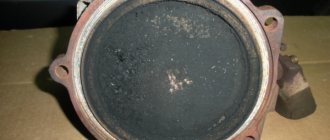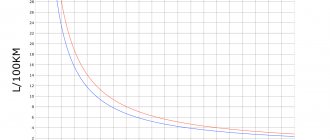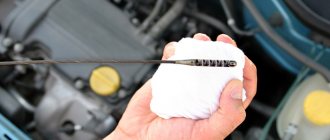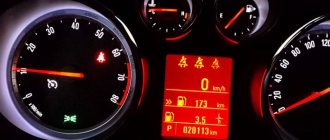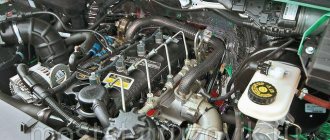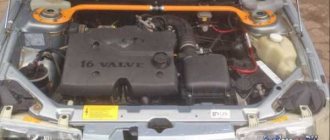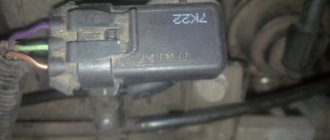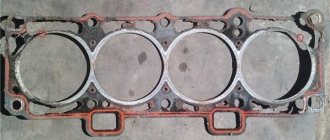Do not interfere with the machine's operation!
Some drivers at traffic lights switch the automatic transmission selector to “parking” - supposedly to extend the life of the unit. They also say that to save fuel, it turns out that when driving downhill, you also need to use “neutral” in the automatic transmission.
Even if such a technique gives illusory savings, it is definitely unsafe. Human life and health are hardly worth a few grams of gasoline. It seems that this is exactly what most automakers thought. For example, the Subaru owner's manual clearly states: "Do not allow the vehicle to move when the selector lever is in the N position." The explanation is simple: when the transmission is open, engine braking becomes impossible, which increases the risk of emergency situations. Kia also talks about possible loss of control. And Nissan adds that this is harmful to the box.
We checked how the car accelerates on AI-92, AI-95 and AI-98 gasoline. What came of it?
How does fuel consumption change depending on what type of gasoline is poured into the tank? An attempt to find an answer to this question was described in the article “Does the type of fuel affect consumption? We conducted experiments on AI-92, AI-95 and AI-98 gasoline.”
However, our tests were not limited to just measuring fuel consumption. Measurements of how much gasoline a 2.8-liter 30-valve V6 consumes were carried out while driving a test Audi A6 along a certain section of the highway in only one direction.
On the way back to the starting point, in addition to the attempts to cause detonation mentioned in the above article, we also found out how the dynamics of acceleration change depending on the type of gasoline used.
There is an opinion among motorists that the type of gasoline poured into the tank greatly affects the dynamic characteristics of the car: the higher the octane number of the fuel, the faster the car accelerates.
For many car owners, this truth is obvious and beyond doubt. What then to do with the popular wisdom “trust, but verify”? So, returning to the start after each next measurement, in addition to how much the car “eats,” we found out how it would accelerate on this or that gasoline if the road situation required quick acceleration.
There are several reasons for the delay in announcing the results of testing the influence of AI-92, AI-95 and AI-98 gasolines on acceleration dynamics. The main one is related to the measurement technique.
Not because we are not looking for easy ways, but in order to eliminate errors associated with turning the stopwatch on and off manually when passing control posts, and because the tachometer has a larger and more informative scale than the speedometer, we decided to focus on tachometer, and film the acceleration process on a video camera. Since the shooting was carried out at a speed of 30 frames per second, all that remained was to make a storyboard of all the video files at home and from it take the numerical information we needed.
Our method will probably make professional filmmakers smile, because they know what a labor-intensive process we have doomed ourselves to by choosing it. The lengthy procedure for analyzing video materials also turned out to be due to the need to be distracted by other work.
The owner of an Audi A6 has already tried it. The video he sent shows that this angle and quality of filming really give a complete picture of what is happening with the devices.
And storyboard screenshots provide clear information that is needed for analysis.
This time, videos from which it was impossible to accurately determine the time spent accelerating from 2500 to 5000 rpm had to be excluded from consideration altogether. The results of the races, where there is no clarity on fuel consumption during acceleration, were left, since determining the efficiency was an incidental, but not the main goal of the test to evaluate the acceleration dynamics.
It remains to add that, in contrast to the races to check efficiency, which were carried out with a travel limiter under the gas pedal and in a forcibly fixed 4th gear, all “dynamic” attempts were carried out without stopping under the gas pedal, when pressing the pedal in floor and in 3rd gear. On the test section of the route, two control sections were chosen with clear guidelines for where to start acceleration, so there are also two tables in which the results are summarized.
Let us remind you that the results of the first races to check fuel consumption greatly puzzled us, because contrary to the theory and assurances of experts, fuel consumption on 92nd gasoline turned out to be less than on 95th. Unfortunately, for the reasons stated above, the very first attempt at acceleration on the AI-92 “failed”, but even without it it is clear that the car also accelerated faster on this type of fuel, as evidenced by a comparison of the results shown in the first five attempts on second test site. This also came as a surprise.
The surprises with fuel consumption that 92nd gasoline presented at the very beginning of the tests led to the fact that, after consulting, we decided to ride the AI-92 again immediately after testing the AI-98. However, even after a series of repeated runs, we did not find confirmation of the fact that 92 gasoline, as one of the readers figuratively put it when discussing an article devoted to comparing fuel consumption, holds the car by the “tail.”
We will not pretend to the ultimate truth, but we can state that on a specific car, under the road and weather conditions during the day when the tests were carried out, we did not find a significant loss for the AI-92 either in fuel consumption or in acceleration dynamics. compared to AI-95 and AI-98.
Let us remind you that 92nd gasoline was not the fuel recommended by the manufacturer for the engine of the test Audi. It is noteworthy that the topic of efficiency recently came up in a conversation with the owner of a KIA Sportage 2.0. He filled the car with AI-95, by default adhering to the generally accepted opinion that on the 95th the car consumes less and drives faster. After reading our article about the effect of gasoline grade on consumption, the owner decided to try AI-92, taking advantage of the fact that in his case the octane requirement specified by the manufacturer is min.92, which means that the factory recommendations will not be violated. The Sportage's mileage already far exceeds the short distance we tested over. According to the owner, there is no loss in dynamics; fuel consumption according to the BC readings has decreased!
Maybe someone will think about the lost profits, but others won’t - who knows until you check it yourself?
| Overclocking results on the first test section | |||
| Video recording time, h.m. | Gasoline grade | Acceleration time from 2500 to 5000 rpm, s | Amount of fuel consumed, ml |
| 11.09 | AI-92 | 13,2 | 138 |
| 12.32 | AI-95 | 13,2 | — |
| 13.21 | AI-95 | 13,5 | — |
| 13.40 | AI-95 | 13,2 | 131 |
| 14.15 | AI-98 | 12,9 | 133 |
| 14.34 | AI-98 | 13,1 | — |
| 15.29 | AI-92 | 13,4 | — |
| 15.49 | AI-92 | 13,6 | 140 |
| 16.06 | AI-92 | 13,3 | 134 |
| Overclocking results on the second test section | |||
| Video recording time, h.m. | Gasoline grade | Acceleration time from 2500 to 5000 rpm, s | Amount of fuel consumed, ml |
| 10.53 | AI-92 | 12,5 | — |
| 11.11 | AI-92 | 12,9 | 139 |
| 12.34 | AI-95 | 13,4 | 140 |
| 13.23 | AI-95 | 13,2 | 137 |
| 13.42 | AI-95 | 13,1 | 135 |
| 14.17 | AI-98 | 13,4 | — |
| 14.38 | AI-98 | 13,3 | 140 |
| 15.31 | AI-92 | 13,1 | 137 |
| 16.26 | AI-92 | 13,0 | — |
Sergey BOYARSKIKH Photos and videos of Vadim ZENKEVICH and the owner of the Audi A6 ABW.BY
Instead of an epilogue
Basic truths can be trusted. And this is natural, because they are confirmed by experience. Well, newfangled statements should be substantiated and proven, otherwise they remain theoretical assumptions.
Expert commentaryWE DRIVE ECONOMICALLYDenis Zagarin, head of the NAMI Test Center The most economical mode is to accelerate to the desired speed by pressing the accelerator pedal 2/3 of its stroke. These acceleration conditions were incorporated into the standard urban driving cycle, which is part of the NEDC driving cycle for assessing vehicle fuel efficiency. Currently, a more dynamic WLTP driving cycle is being implemented with intense acceleration, during which fuel consumption increases sharply in urban conditions. Hence the general wish: avoid sudden acceleration and braking. The engine braking mode, compared to switching to neutral, provides an advantage in efficiency, since this stops the fuel supply to the engine. Don’t forget about the safety rules - on cars with automatic transmission it is forbidden to move the selector to “neutral” not only on descents, but also when driving in a straight line. When it comes to driving trucks economically, it's worth paying attention to the specific power of the engine. The larger it is, the more preferable smooth acceleration will be. However, with a specific power of less than 6.0 hp. per ton it is more profitable to accelerate sharply, since it is difficult for the engine to accelerate when operating at less than full power. It turns out that without a load, smooth acceleration is more economical, but at full load everything depends on the specific power of the engine. |
Injection cars
With this design of the fuel system, there are fewer options for incorrect behavior of the car during acceleration. And special diagnostic tools will help identify problems associated with fuel equipment, and this is a direct route to the nearest service station. You are unlikely to be able to fix the problems yourself.
The main reasons for poor acceleration or jerky acceleration include low fuel pressure in the system, failure of the mass air flow sensor and air sensing sensor. Possible acceleration problems may arise due to a malfunction in the ignition system, which can also be identified using special diagnostic equipment for components.
In most cases, problems with acceleration arise on the road (and this is natural), when it is not possible to quickly get to a car service center. In such cases, it is possible to carry out diagnostics yourself; for this you need to visually inspect and check the reliability of the connection of the wires to the ignition coils. You can also start the car engine and open the hood to listen to the engine running. The clicks of electricity during breakdown should be clearly audible, and in dim lighting you can still see the spark itself.
There is such a malfunction as the failure of one or more engine cylinders. It manifests itself in a noticeable decrease in engine power: the car accelerates poorly and has difficulty negotiating various inclines. This malfunction can be identified visually by inspecting the running engine. There will be a noticeable strong vibration of the engine, a change in sounds, and the idle speed will begin to change. In addition, fuel consumption will increase significantly. As a result, a decrease in engine power leads to its unstable operation and inadequate behavior during acceleration. There is only one solution - engine repair.
As you can see, in cars with a fuel injection system you can do little on your own, without special equipment, and experiments here are extremely undesirable. If any problems or malfunctions are detected, the surest remedy is to contact specialists.
Ways to increase engine power
- Fuel with gasoline with an octane rating higher than recommended.
- Replace the standard air filter with a zero resistance filter.
- Replace the standard exhaust system with a direct-flow one.
- Engine chip tuning.
- Replacing engine oil with a higher quality and less viscous one.
Loss of engine power is an annoying problem for any motorist. The car does not drive as it should, and sometimes this is very annoying, and sometimes it is completely unsafe, so finding the root causes and eliminating them is an important and necessary task. Good luck on the roads!
An automobile power plant may not develop the required power, and the driver pays attention to this, as a rule, when the drop in dynamics is already obvious. You will hardly notice this if the car accelerates with great difficulty on a dry, hard and level road surface. What is the reason that engine power decreases, and what can be done in this case?
Causes of malfunction
It is worth checking the electronics last, when all the mechanics have already been diagnosed and no problems have been found. You definitely shouldn’t ignore electronics, since they also affect the process of fuel consumption. But you should still entrust the diagnostic process to a specialist, because without the appropriate experience you can only worsen the situation.
The problems described are the most common reasons that cause the feeling that someone is holding the car while accelerating. You can get rid of them by sending your car for diagnostics and repair. To avoid such troubles in the future, it is important to diagnose the machine at least once a year.
How to increase throttle response in simple ways
Every experienced motorist knows and uses his own, favorite way to improve the car's former dynamics. Let's look at the most popular ones, but let's not forget that only eliminating the reasons that contributed to the decline in the power characteristics of internal combustion engines will guarantee a return to their former positions.
- Use fuel with a higher octane number (OC). Indeed, the higher the OC, the better the fuel will resist self-ignition during compression. This will directly affect the greater power from the gas explosion.
- Application of "Suprotek". This is a lubricant that is a composition of several components. This is not an additive or additive, but a special composition that interacts with the metal surfaces of internal combustion engine elements. Excellent for removing wear on metal surfaces.
- Replacing a classic air filter with a modernized one. This way you can ensure that a richer mixture is supplied to the engine.
- Changing the exhaust system. Forward flow helps increase power.
- Turbocharged.
- Replacement of worn parts and much more.
In a word, it is necessary and possible to normalize the engine of your car. It is recommended to do this in professional car services, but if the driver has specific knowledge and the required equipment - in his own garage.
Many people have at least once encountered a situation where a previously working engine “deflates”, and the car seems to grow an anchor at the back. The reasons why the engine does not pull and does not gain momentum are various, but recognizing the signs of most is not difficult even without the skills of an automobile diagnostician or motor mechanic.
Common reasons for all engines
The engine characteristics specified in the vehicle's passport data are provided under certain conditions. This is the normal filling of the cylinders with air, which in an internal combustion engine is the working fluid. This is also an opportunity to heat it to the required temperature in time - to supply a certain amount of fuel of the appropriate quality and ignite it in time (the peak pressure for maximum efficiency should occur at the moment the piston passes the top dead center).
ICE duty cycle
Loss of engine power, regardless of its design, results from a number of common reasons. Let's start with the fuel: its quality remains lottery, but the engine is tuned to a certain grade. That is, the mixture prescribed in the injection maps or set by the carburetor settings may deviate from the ideal one, and the combustion rate of the mixture changes. So, if problems appeared immediately after refueling, you know which way to look.
Filling the cylinders with air is strictly related to the valve timing. It is enough to leave the marks, and the operating cycles of the internal combustion engine will be shifted: already a difference of 1 tooth can significantly reduce the engine power. Moreover, the belt or chain does not have to jump - more and more motors are receiving keyless pulleys, which require rigid fixation of the shafts with special devices during installation. If you don't tighten the pulley, it will one day move from its predetermined position. And it’s good if the engine simply loses traction, and does not hit the piston on the valves that did not close in time, driving them into the cylinder head.
In engines with variable gas distribution, the camshafts (at least one) have the ability to shift so that, with sufficient throttle response at the bottom (small phase overlap), it does not lose at the top (the camshafts move “towards each other”, increasing the overlap phase, which increases power at high speeds ). Possible reasons why the car does not pick up speed are a failure of the VVTi control valve or problems with the phase shifter clutches. We have already discussed this question when talking about.
In addition, the filling of the cylinders is tied to the intake and exhaust resistance. To clog the air filter so much that it loses its flow capacity - this must be done, but oil emissions through the crankcase ventilation system, especially if the piston is already worn out and the oil catcher is primitive, are not uncommon. On a VAZ-2106 it is not difficult to force the engine to “sip oil” through the crankcase ventilation, and even on new front-wheel drive cars (2109, 2110, 2114) such cases are possible. An oily air filter has a sharp increase in resistance, hence the loss of engine thrust.
The exhaust on carburetor cars and old diesel engines is simple, and reducing the flow area sufficiently enough for the engine to start “choking” on exhaust gases can only be done with a powerful blow (when driving over bumps, for example) or with the canonical potato - but at least it’s immediately noticeable.
If the engine with electronic injection does not pull, then the catalyst comes under suspicion in this case. Overheating and ingress of fuel due to malfunctions in the power supply system can cause sintering of its honeycombs. For diesel engines with particulate filters, soot becomes the main enemy: automatic burning of the filter on the go is ineffective, and at a minimum, forced regeneration must be performed.
Problems with the exhaust easily reveal themselves: when the engine is turned off, when you try to start it again, it emits smoke into the intake, the sound of the engine changes, and leaks immediately “crawl” out (the exhaust begins to “cut” to the damaged area).
The engine must not only receive the right amount of air and fuel - it must ignite in time. A gasoline engine requires an appropriate ignition timing; a diesel engine requires an injection timing. Since modern injection engines do not have a separate ignition system, problems with ignition timing are primarily characteristic of carburetor cars and old injection systems with a distributor (the Japanese used such systems right up until the early 2000s). Check the basic advance angle, adjusted by the distributor, and the operation of the advance machines in it (if there is a malfunction, the angle that is normal at idle will begin to “go away” when the speed increases).
A separate case is engines where the distributor is driven by a separate pulley from the timing belt (old Audis and Volkswagens). Here, when replacing the belt, the distributor pulley is placed “as needed” (there are no marks on this pulley!), forgetting that when replacing the belt, the distributor must be oriented with the cam along the risk on the crankcase under it. After such a replacement, the car stops driving because the ignition angles change. For diesel engines with a mechanical injection pump, the initial injection angle is set, in addition, the advance regulator works - they are checked according to the data from the repair and maintenance instructions.
On gasoline engines, we also include spark plugs as suspects: even if the engine operates normally at idle, it is not a fact that the spark plugs will work well under load, when the pressure in the cylinders at the end of the compression stroke increases and the conditions for sparking become worse. It’s worth installing another set for testing: without an oscilloscope that allows you to take voltage curves from a working ignition system, it’s difficult to determine how the spark plug actually behaves under load. In the illustration below, look at the peak voltages corresponding to the moment of spark formation: in the third cylinder the gap is excessively widened, the spark flares up at too high a voltage, and its duration drops (the power accumulated in the ignition coil is not enough for the spark to burn normally).
If we talk about compression, then under normal conditions it decreases with wear so slowly that the decrease in power occurs unnoticed by the driver. An exception is rapidly developing breakdowns (cracks of piston rings, destruction of partitions between rings, etc.). Simultaneously with the drop in power, the idle stability will sharply drop; the final diagnosis will definitely be made by a compression meter.
As for turbocharged engines, the condition of the turbocharger has a good effect on their dynamics. An ideal centrifugal pump (turbocharger impeller) has a quadratic dependence of performance on rpm: as soon as the rpm drops by half, the boost pressure drops by four. Wedging of the rotor due to destruction or coking of the bearings, burning of the “hot” impeller is the probable reason why a turbocharged car does not pull. Here, as with compression, a pressure gauge will help out.
